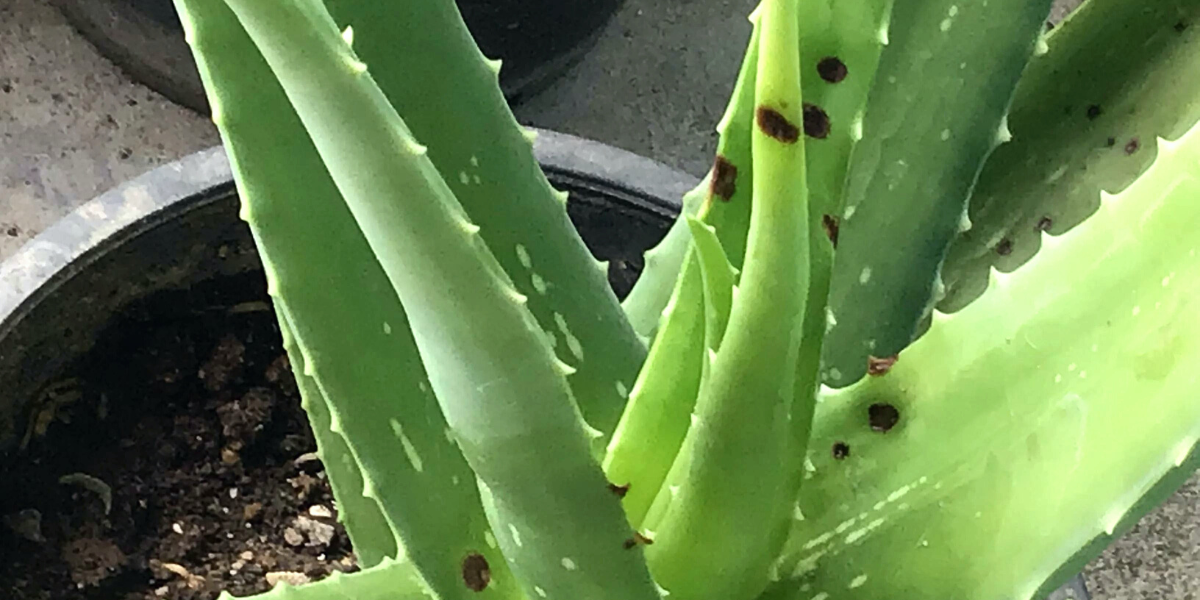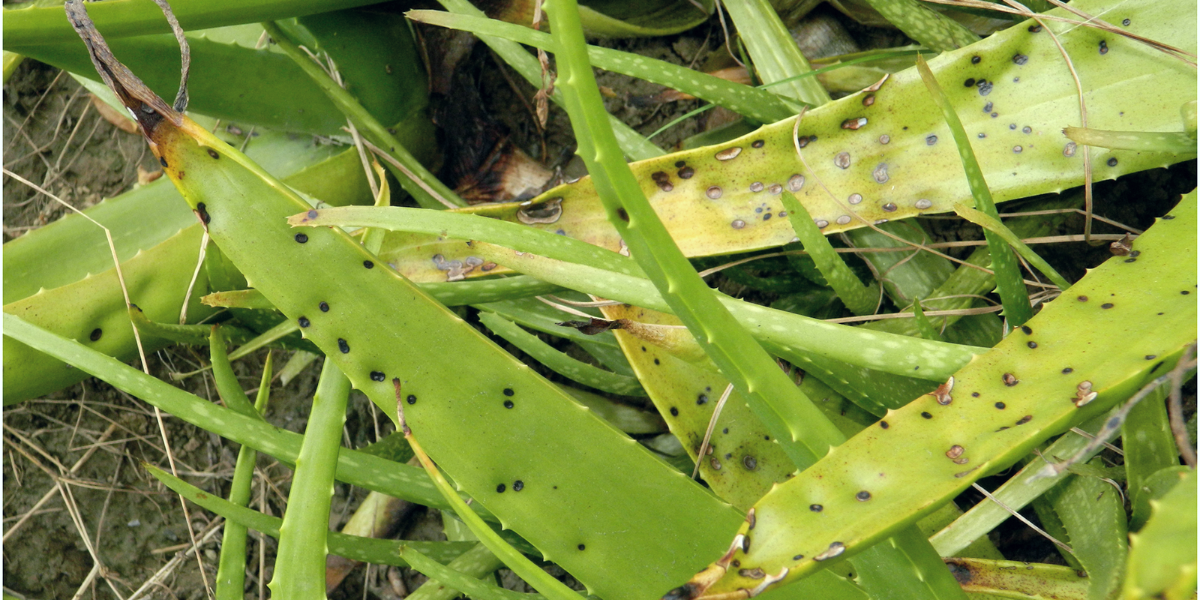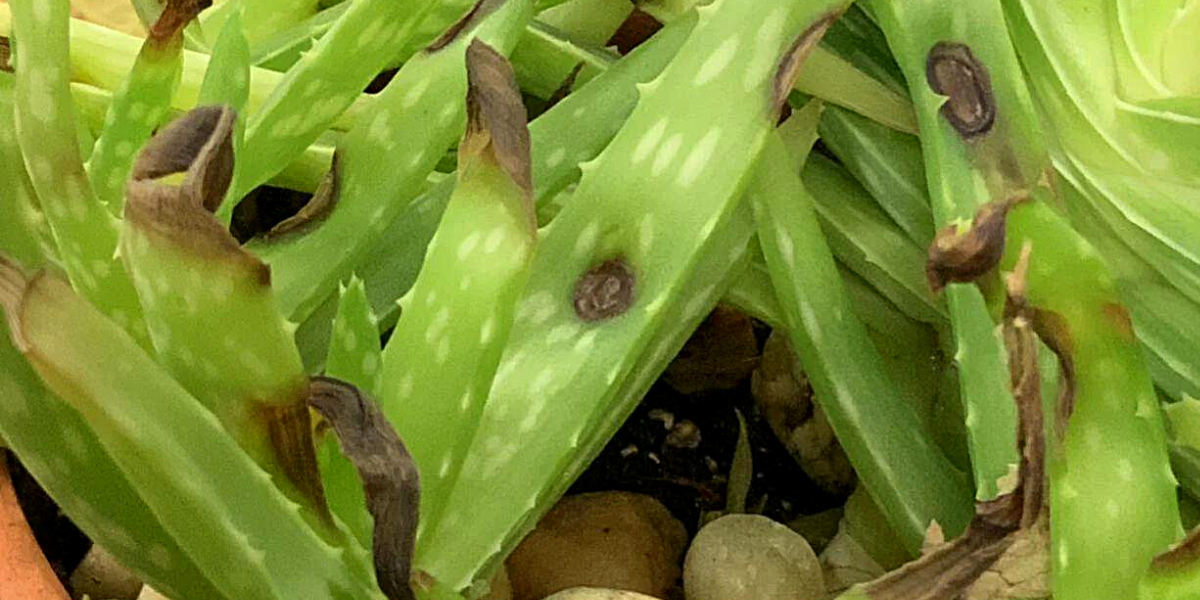Aloe Vera is an incredibly beneficial plant with proven medicinal properties. It is native to the arid regions of the Middle East and Africa. Due to the hot and often extreme climatic conditions in its homeland, this plant is used to surviving in the absence of sufficient watering and dry air. That is why Aloe Vera is considered one of the most unpretentious houseplants. Its distinctive feature is thick and juicy “leaves” with small spines along the edges. In them, it accumulates moisture, thanks to which it lives in dry periods.
However, if Aloe Vera can easily survive the inattentive attitude of its owner and infrequent watering, then excessive moisture can greatly harm this succulent and even kill it. One of the characteristic symptoms of poor health is the appearance of dark spot Aloe Vera. We will take a detailed look at what diseases such changes may be indicators of, how to identify and classify a specific problem, and how to save your favorite plant.
Dark Spot Aloe Vera Overview
Even though Aloe Vera survives in conditions in which most other plants quickly die, there are still certain causes for this flower to get sick. The appearance of dark spots indicates Aloe Vera is not feeling very well, which means you need to look for other symptoms.

“Black dots” are a fairly general concept that can hide a variety of changes that appear on Aloe leaves. They may have clear contours, as from sunburn, or blur in the form of blots, as they were formed due to a fungal infection. Since dark spots can be indicators of various diseases, the reasons for their appearance also vary. The main ones include the following:
- Excessive watering. It is the most common cause of dark spots. The fact is that in the leaves of Aloe Vera, there are special tissues that can perfectly accumulate moisture. If there is too much liquid, dark spots begin to appear on the surface of the leaves. When a succulent is left in damp soil for too long, it leads to a more severe problem called root rot. Because of it, Aloe Vera can even die completely.
- Hypothermia. A plant accustomed to life in arid areas, it is difficult to tolerate temperature extremes, cold, and drafts. If the room temp drops below 60°F, the soil in the pot will not dry out to the desired level. If the room gets even colder, there is a chance that the moisture contained in the leaves will freeze and damage their surface.
- Dry air. Although, like all succulents, this indoor plant is quite drought-tolerant, too dry air can also be harmful to it. The optimum humidity level is about 40%. If this indicator drops below, dark spots may appear on the leaves of Aloe Vera because of the violation of the natural photosynthesis processes.
- Sunburn. We wrote that Aloe Vera is used to growing in dry areas. However, direct sunlight can cause burns on the leaves, which appear as dark spots. They may not have a serious impact on the plant’s health, but they ruin its appearance. Also, burns occur if you water or sprinkle a flower and droplets accumulate on the leaves. Refracted sunlight can cause severe burns.
- Fungus. The likelihood of fungal diseases increases in the cold months. If you stick to the old watering regime, the soil does not dry out enough, which leads to the development of fungus and other infectious Aloe plant diseases. Usually, they have characteristic symptoms, which we will discuss below.
- Bacteria. Aloe Vera is not often susceptible to bacterial infections. However, dark spots may indicate the presence of the so-called Pectobacterium Chrysanthemi, which provokes soft rot.
- Pests. Mites, aphids, and mealybugs are very fond of settling on Aloe Vera plants weakened due to improper watering. Fortunately, they are quite noticeable, so in addition to dark spots on the leaves, you will find other signs.
By the way, it is important to know that Aloe Vera does not need to be fertilized because it is used for growing in soils poor in useful elements. However, some growers still use plant food and even too often. It can also lead to dark spots on the leaves. Although, in comparison with overwatering, such a scenario is unlikely.
The reasons for the appearance of dark spots can be very different. Some of them will not require you to take a certain action; others should be taken much more seriously. All of the infections that can cause spots on Aloe Vera kill flowers fairly quickly and move from one pot to another. Therefore, it is extremely important to identify the underlying problem on time and get rid of it before it is too late.
Black Spots on Aloe Plant: Symptoms and Diagnosis
Dark spots are just some of the signals that Aloe Vera can send you if it feels unwell. For accurate classification, you need to look for other symptoms that will help you better navigate.

Here are the major diseases that are associated with the appearance of dark spots and their characteristics:
- Root rot. Excessive watering, low temperatures, and the constant presence of the plant in a humid environment lead to rotting of the root system. To detect underground plant diseases, you have to get Aloe Vera out of the pot. The roots will be damaged, slippery, blackened, and brittle. In a neglected state, rot can even rise above the ground and affect the trunk. At the same time, the soil and roots will emit an extremely unpleasant smell. Since the root system of Aloe is not very developed, this disease can cause the flower to break and fall simply.
- Hypothermia. It leads to the fact that dark spots appear on the leaves, which gradually cover the entire surface, and the damaged parts begin to rot and fall off. If such leaves are not removed in time, they will infect the whole plant.
- Sunburn. As a rule, they are not accompanied by additional signs other than dark spots. However, if Aloe Vera has been exposed to the sun for too long, particularly severely damaged leaves may turn yellow, then pale, and become sluggish.
- Low humidity. Under such conditions, plant growth slows down (compared to average rates); in addition to dark spots, the leaves become soft and may even fall off.
- Bacteria. In addition to the growing dark spots that seem to “move” along Aloe Vera, you will feel an extremely unpleasant smell.
Fungal diseases:
- Aloe Vera rust. Brown spots appear on the surface of the leaves, which blacken over time. Fungal spores can be found on the joints. The leaves are gradually falling off.
- Anthracnose. It appears as dark dots (similar to burns) with orange or yellow edges. Gradually, individual dots merge into large spots, affecting more and more plant parts.
- Basal stem rot. Dark brown, almost black rot spots appear on the trunk of Aloe Vera.
- Leaf spot disease. It is similar in appearance to Anthracnose. Dark brown dots gradually grow, merging into large spots and affecting the entire plant.
Insect pests:
- Mites look like tiny orange worms. They eat your plants, leaving behind “rusty” tracks that darken over time.
- Mealybugs are oval in shape and white or pale beige. They are known for leaving behind a sticky white substance that looks like cotton wool or snow. Bite spots on leaves are pale at first but gradually turn into dark dots.
- Aphids are green oval insects with long antennae on their heads. Because of them, the growth of flowers is inhibited. They also leave sticky honeydew behind.
Many symptoms indicate the development of serious problems that are important to identify on time to stop the disease cycle. Otherwise, you risk losing the plant completely and, at the same time, infecting neighboring pots. Since Aloe Vera leaf color changes can be indicative of a wide variety of black spot diseases, making an accurate diagnosis can be tricky. The best way to do it is to use the problem identification app in addition to your own knowledge:
- For correct analysis, the plant should be removed from the pot, and the roots should be slightly cleaned from the ground (try not to damage them). All infected parts should be clearly visible in the photos.
- Using the application, take a picture of your plant or upload your existing photos from the device’s gallery.
- The system will analyze the information provided and offer you a list of the most likely diseases. The first one will be the one with the most matching symptoms.
Through the use of the application, you can most accurately determine the disease and choose the best chemical or natural treatment.
Aloe Black Spots Treatment
Depending on what kind of changes in the plant’s appearance is complemented by dark spots, you should look for a solution to the problem.

Root rot
If the damage to the root system is not too serious yet, and you notice the problem in time, it is enough just to dry the ground and establish proper watering. If the rot has spread far enough, you will need to remove Aloe Vera from the pot and cut off the affected parts. Be sure to disinfect them and transplant the succulent into fresh soil to prevent recurrence and transmission of the disease to healthy parts. When transplanting, make sure that the water drainage holes are not blocked, and the drainage layer is sufficient so that moisture does not stagnate.
Hypothermia
It is best to immediately move the plant pot to a warmer room where the temperature fluctuates around 60-75°F. If it is impossible, give Aloe Vera good insulation by wrapping it in a blanket. You can also install artificial lighting that will warm the flower (the main thing is not to put the lamp too close so as not to cause burns). During the colder months, the plant should be watered less frequently.
Burns
Aloe Vera loves bright but indirect light. If the plant has sunburn, close the curtains or move the pot to the shade. Unfortunately, dark spots will remain on the leaves, but new shoots will be without them. Besides, this way, you stop the deterioration of the plant condition.
Too low humidity
If possible, move the pot to a room with higher humidity. However, in this case, there is a risk of fungal diseases with improper watering. You can also use a humidifier or just lightly mist the leaves with a spray bottle. Try to regularly measure the humidity level and keep it around 40%.
Fungal diseases
Treatment of all types of fungal diseases can be reduced to a few general steps. Firstly, you need to stop watering temporarily and reduce air humidity. Secondly, all affected parts of Aloe Vera should be cut off, including the roots. Don’t be afraid to prune too much, as it will prevent infection of healthy leaves and roots. And thirdly, the diseased plant should be treated with a fungicide to kill the spores of the fungus. After these actions, the flower should be transplanted into new soil and not watered for some time. Be sure to quarantine your Aloe so that it doesn’t infect other plants.
Bacteria
Unfortunately, it is one of the most severe causes of dark spots on Aloe Vera. If a large part of the plant is affected, the only sure option is to throw it away. If there are any healthy parts left on it, you can cut them off and try to root them in any way suitable for Aloe. The main thing is to make sure that the pieces you choose are healthy.
Pests
Insecticides will save you from the invasion of any insects. To begin with, try to remove most of the pests manually. For example, mix dishwashing detergent and alcohol and rub the leaves and joints with this solution. You can then apply chemical treatments or opt for a natural remedy like neem oil or insecticidal soaps. Keep in mind that pest control requires your regular attention, so applications will need to be done at least once a week until all insects are dead.
It is necessary to adhere to the correct regimen of watering, temperature, and humidity to prevent the recurrence of dark spots and make Aloe Vera resistant to any other diseases. When caring for this plant, it is better not to overdo it since almost all problems are due to excessive moisture. Make sure the top layer of soil is completely dry before watering it again. Try to prevent water from entering the junction of the leaves and the trunk; otherwise, the stagnant liquid can provoke a relapse. Healthy Aloe Vera is not only a decoration for your home garden but also a useful remedy for cuts and burns, as its juice has healing properties.
Leave a Reply
You must be logged in to post a comment.